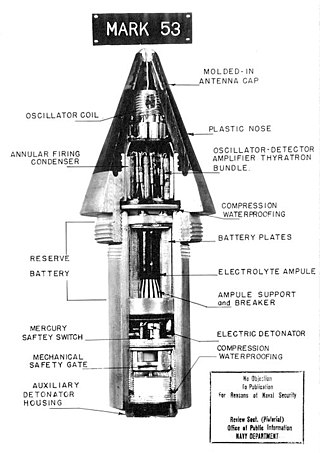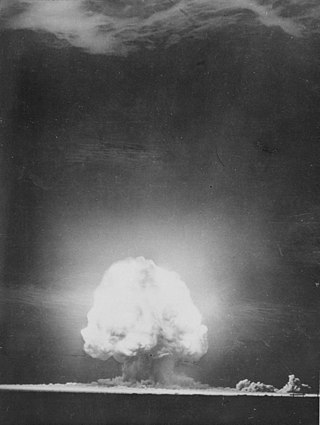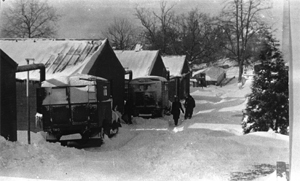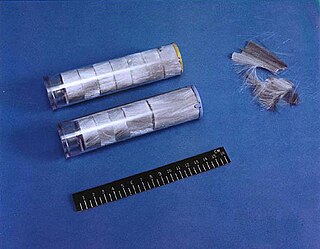Related Research Articles

Ultra was the designation adopted by British military intelligence in June 1941 for wartime signals intelligence obtained by breaking high-level encrypted enemy radio and teleprinter communications at the Government Code and Cypher School (GC&CS) at Bletchley Park. Ultra eventually became the standard designation among the western Allies for all such intelligence. The name arose because the intelligence obtained was considered more important than that designated by the highest British security classification then used and so was regarded as being Ultra Secret. Several other cryptonyms had been used for such intelligence.

Anti-aircraft warfare, counter-air, anti-air, AA, flak, layered air defence or air defence forces is the counter to aerial warfare. It is defined by NATO as "all measures designed to nullify or reduce the effectiveness of hostile air action". It includes surface based, subsurface, and air-based weapon systems, associated sensor systems, command and control arrangements, and passive measures. It may be used to protect naval, ground, and air forces in any location. However, for most countries, the main effort has tended to be homeland defence. Missile defence is an extension of air defence, as are initiatives to adapt air defence to the task of intercepting any projectile in flight.

A proximity fuze is a fuze that detonates an explosive device automatically when it approaches within a certain distance of its target. Proximity fuzes are designed for elusive military targets such as airplanes and missiles, as well as ships at sea and ground forces. This sophisticated trigger mechanism may increase lethality by 5 to 10 times compared to the common contact fuze or timed fuze.

Technology played a significant role in World War II. Some of the technologies used during the war were developed during the interwar years of the 1920s and 1930s, much was developed in response to needs and lessons learned during the war, while others were beginning to be developed as the war ended. Many wars have had major effects on the technologies that we use in our daily lives, but World War II had the greatest effect on the technology and devices that are used today. Technology also played a greater role in the conduct of World War II than in any other war in history, and had a critical role in its outcome.

Reginald Victor Jones, FRSE, LLD was a British physicist and scientific military intelligence expert who played an important role in the defence of Britain in World War II by solving scientific and technical problems, and by the extensive use of deception throughout the war to confuse the Germans.

Oleg Vladimirovich Penkovsky, codenamed Hero and Yoga was a Soviet military intelligence (GRU) colonel during the late 1950s and early 1960s. Penkovsky informed the United States and the United Kingdom about Soviet military secrets, including the appearance and footprint of Soviet intermediate-range ballistic missile installations and the weakness of the Soviet intercontinental ballistic missile program. This information was decisive in allowing the US to recognize that the Soviets were placing missiles in Cuba before most of them were operational. It also gave US President John F. Kennedy, during the Cuban Missile Crisis that followed, valuable information about Soviet weakness that allowed him to face down Soviet leader Nikita Khrushchev and resolve the crisis without a nuclear war.

H2S was the first airborne, ground scanning radar system. It was developed for the Royal Air Force's Bomber Command during World War II to identify targets on the ground for night and all-weather bombing. This allowed attacks outside the range of the various radio navigation aids like Gee or Oboe, which were limited to about 350 kilometres (220 mi) of range from various base stations. It was also widely used as a general navigation system, allowing landmarks to be identified at long range.

The Telecommunications Research Establishment (TRE) was the main United Kingdom research and development organisation for radio navigation, radar, infra-red detection for heat seeking missiles, and related work for the Royal Air Force (RAF) during World War II and the years that followed. It was regarded as "the most brilliant and successful of the English wartime research establishments" under "Rowe, who saw more of the English scientific choices between 1935 and 1945 than any single man."
Paul Rosbaud, was a metallurgist and scientific adviser for Springer Verlag in Germany before and during World War II. He continued in science publishing after the war with Pergamon Press in Oxford, England. In 1986 Arnold Kramish revealed the undercover work of Rosbaud for the British during the war in the book The Griffin. It was Rosbaud who dispelled anxiety over a "German atom bomb".

Chaff, originally called Window or Düppel, is a radar countermeasure involving the dispersal of thin strips of aluminium, metallized glass fiber, or plastic. Dispersed chaff produces a large radar cross section intended to blind or disrupt radar systems.

Anti-submarine warfare is a branch of underwater warfare that uses surface warships, aircraft, submarines, or other platforms, to find, track, and deter, damage, or destroy enemy submarines. Such operations are typically carried out to protect friendly shipping and coastal facilities from submarine attacks and to overcome blockades.

The SCR-584 was an automatic-tracking microwave radar developed by the MIT Radiation Laboratory during World War II. It was one of the most advanced ground-based radars of its era, and became one of the primary gun laying radars used worldwide well into the 1950s. A trailer-mounted mobile version was the SCR-784.
Johannes "Hans" Plendl, German radar pioneer, was the scientist whose airplane navigation inventions made possible the early German bombing successes in World War II.
The Allies of World War II cooperated extensively in the development and manufacture of new and existing technologies to support military operations and intelligence gathering during the Second World War. There are various ways in which the allies cooperated, including the American Lend-Lease scheme and hybrid weapons such as the Sherman Firefly as well as the British Tube Alloys nuclear weapons research project which was absorbed into the American-led Manhattan Project. Several technologies invented in Britain proved critical to the military and were widely manufactured by the Allies during the Second World War.
Hans Ferdinand Mayer was a German mathematician and physicist. He was the author of the "Oslo Report", a major military intelligence leak which revealed German technological secrets to the British Government shortly after the start of World War II.

An artillery fuze or fuse is the type of munition fuze used with artillery munitions, typically projectiles fired by guns, howitzers and mortars. A fuze is a device that initiates an explosive function in a munition, most commonly causing it to detonate or release its contents, when its activation conditions are met. This action typically occurs a preset time after firing, or on physical contact with or detected proximity to the ground, a structure or other target. Fuze, a variant of fuse, is the official NATO spelling.

Military intelligence on the V-1 and V-2 weapons developed by the Germans for attacks on the United Kingdom during the Second World War was important to countering them. Intelligence came from a number of sources and the Anglo-American intelligence agencies used it to assess the threat of the German V-weapons.

Operation Leader was an air attack conducted against German shipping in the vicinity of Bodø, Norway, on 4 October 1943, during World War II. The raid was executed by aircraft flying from the United States Navy aircraft carrier USS Ranger, which was attached to the British Home Fleet. The American airmen located many German and Norwegian ships in this area, destroyed five and are believed to have damaged another seven. Two German aircraft searching for the Allied fleet were shot down. Three American aircraft were destroyed in combat during the operation, and another crashed while landing.

The Secret Intelligence Service (SIS), commonly known as MI6, is the foreign intelligence service of the United Kingdom, tasked mainly with the covert overseas collection and analysis of human intelligence on foreign nationals in support of its Five Eyes partners. SIS is one of the British intelligence agencies and the Chief of the Secret Intelligence Service ("C") is directly accountable to the Foreign Secretary.
Oberleutnant Herbert Schmid was a German World War II pilot who defected to north-east Scotland in May 1943, piloting a German nightfighter with advanced interception radar which allowed British scientists to jam German nightfighter radar.
References
Notes
- ↑ West, Nigel (1983). MI6: British Secret Intelligence Service Operations, 1909-45. Random House. ISBN 0-394-53940-0.
- ↑ R.V. Jones. Air Scientific Intelligence Report No. 7, The Edda Revisited, 17 July 1940. Churchill Archives Centre, Cambridge University, Reginald Victor Jones Papers, RVJO B.24
- ↑ R. V. Jones (1989), p. 275.
- ↑ Public Record Office, AIR 40/2572.
- ↑ F.H. Hinsley (1979), Appendix 5.
- ↑ R.V. Jones (1989), Appendix A.
- ↑ Franken at german-navy.de Retrieved 26 June 2011.
- ↑ R. V. Jones. Scientific Intelligence. J. Royal United Services Institution, 42: 352–369, 1947.
- ↑ R. V. Jones (1978), p. 71.
Bibliography
- Brown, Louis.(1999) A Radar History of World War II: Technical and Military Imperatives, Bristol: Institute of Physics Publishing, ISBN 0-7503-0659-9.
- Johnson, Don H. Scanning Our Past - Origins of the Equivalent Circuit Concept: The Current-Source Equivalent, Proc. IEEE, 91:817–821, May 2003.
- Jones, Reginald V. (1978) Most Secret War: British Scientific Intelligence 1939–1945. London: Hamish-Hamilton, ISBN 0-241-89746-7. Published in the United States as The Wizard War: British Scientific Intelligence 1939–1945, New York: Coward, McCann & Geoghegan, ISBN 0-698-10896-5.
- Jones, Reginald V. (1989) Reflections on Intelligence. London: Heinemann, ISBN 0-7493-0474-X.
- Sterrenburg, Frithjof A.S. "The Oslo Report". v2rocket.com.